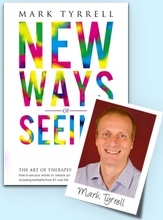
Help your clients release the unfulfilled emotion that dreaming is trying to express
It was quite a story.
“I keep having this recurring nightmare, every couple of weeks. I’m trying to steer this ship through stormy seas. Although the sea is rough, it’s always a sunny day. I’m responsible for the ship and as I steer it, looking for calmer waters, I suddenly have this sense of foreboding. I know something awful is coming. Then, even though I’m expecting something horrid, I’m shocked to see a hideous witch with two heads approach me, with a horrible smile.
“She comes and grabs the wheel and turns the ship off course… I try to move my hands but I look down and see they are tied to the wheel, and I can’t move them. Suddenly the witch pulls out a sharp knife and begins stabbing me, smiling all the while… I feel my life ebbing away and at this point I often wake up in a sweat… It takes me ages to go back to sleep.”
Jill looked at me shyly after she had recounted this dream and said, “Why do I have this dream? Am I going crazy?”
As we’ll see in a moment, Jill was certainly not going crazy and in fact her dream closely mirrored a waking concern she had.
Prefer to watch instead?
Dream analysis: a beginner’s guide
The latest understanding of what dreams do and what they can mean comes from psychologist Joe Griffin, the co-founder and pioneer of Human Givens psychology (1). Joe Griffin has also shown why depressed people over-dream, and why that causes the symptoms of depression (2). Dreaming occurs during REM sleep. After studying hundreds of dreams in the context of neurology and psychology, Griffin found that we all dream, whether we recall those dreams or not, and what we dream about is unfulfilled arousal.
What this means is that, if we generate an emotional arousal such as a worry during the day but go to bed without having in some way resolved (‘switched off’) that emotional expectation, then we will dream it out symbolically.
So one important function of dreaming is to flush out our emotional expectation by completing it symbolically, thereby freeing up the neo-cortex for the next day’s emotional expectations. If people solve their problems and/or learn not to worry about them so much, they will have a normal proportion of dream/REM sleep – about 25% of their total sleep.
But if they worry and ruminate and churn things over without resolving them in any way, then they will dream more as the brain attempts to clear the build up of emotional arousal.
This increased dreaming time cuts into what would normally be deep sleep non-dreaming time, when the mind/body is in full rest and recuperation mode. So chronic over-dreaming can eventually lead to the exhaustion so often seen in clinical depression.
There are two important things to remember about dreams:
- Dreams deactivate emotional arousal which has remained unfulfilled during waking hours. (If I have to stifle a laugh during the day, I might find myself waking up laughing the next morning from some hysterical incident in a dream. The ‘circuit’ begun during waking hours is completed in the dream, and so that particular arousal can be switched off.)
- Dreams are always cloaked in the language of metaphor and symbolism.
3 ways to help a client understand their troublesome dreams
1) Throw away the dream dictionary
You might have seen those one size fits all ‘Dream Dictionaries’ that aim to tell you the meaning of every possible dream symbol. “If you dream of an umbrella it means you are going to lose money” or “If you dream of a banana it means your skin is going to peel in the sun” and all kinds of quite arbitrary interpretations. We’re all human and it’s not surprising that some common symbols show up in everyone’s dreams.
But when you look closely at the actual lives of the dreamers it’s clear that people are expressing symbols borrowed from their own recent experience. In Jill’s case, she had been watching a TV show about sailing just before she started having her recurring dream. Many of the symbols of the dream will simply be the ‘dressing’ for the real content of what the dream is about.
2) Look at the feelings your client had during the dream
It’s not just what happens in a dream that is important but how your client feels during the dream, and what unresolved emotional concern the dream feeling may be expressing. I asked Jill if anything was upsetting her in her life on an on-going basis. “Think really hard Jill. Do the feelings you have in that dream seem to match any feelings you have in everyday life?”
Jill was pensive for a while, and then…
“Well, I don’t think so… well, there is one issue. My mother-in-law often visits us on a Sunday [the ‘sunny day’ of the dream?]. She just shows up, without warning, and sort of takes over everything. It’s like she’s saying I can’t be a proper mother or wife [the witch tries to steer the ship off course].
“She’s always nice to my face, but I know she’s said some horrible things about me to my husband. She’s quite two faced [the witch has two heads]. It’s like she’s nice to me but stabs me in the back at the same time [the witch has a knife and starts stabbing]. I feel like I can’t say anything to her, because she loaned us quite a lot of money…”
“So your hands are tied?” I said. “Yes!” Jill laughed. “Just like they are tied to the ship’s wheel in the dream!” The problem of these visits had not been resolved. They were on-going.
Nature, being economical, used the same symbolism over and over when seeking to complete the emotional pattern of Jill’s concerns. So it is unresolved emotional expectation that we dream about, and the symbolism of the dream is just the dressing (to use a metaphor). Most dreams effectively flush out unfulfilled expectation and are forgotten, and in a way this is how it’s meant to be.
But if a dream is troubling someone we can identify what unresolved worry or expectation it is mirroring by looking at the feelings in the dream. This lets us know what the client has been worrying about, and when we address those worries the dreams stop.
3) Seek to complete the emotional loop in waking life
In Joe Griffin’s wonderful book Dreaming Reality: How Dreaming Keeps Us Sane, or Can Drive Us Mad he describes how a refugee who had escaped the horrors of Bosnia in the early 1990s was afraid that he and his family might be sent back to his war-torn homeland. He kept dreaming of a live grenade exploding in his mouth, killing him and his family.
Fortunately, a nurse knew about Griffin’s dream research and asked him what his biggest worry was. When he told her he feared that he might say something in his poor English that would cause them to be sent back, she reassured him that it didn’t matter what he said, he was quite safe in England. The recurring nightmare stopped immediately. Understanding Griffin’s work means we can analyze our clients’ dreams to discover what is really bothering them that needs to be resolved.
We can also use it to help them complete the ’emotional circuit’ and switch off their unfulfilled emotional expectations by helping them either practically solve the worry or learn to feel differently about it. The content of your client’s dream will always relate to waking concerns from the day before they had the dream.
Jill was pretty nervous of her mother-in-law. But I helped her mentally rehearse feeling confident and calm enough to set boundaries and to take back her own “steering wheel”. As soon as she started setting limits and being firm with her mother-in-law, the dreams stopped.
If you’re interested in how this insight into dreams can help lift depression, we teach this on our course How to Lift Depression Fast.
Notes:










